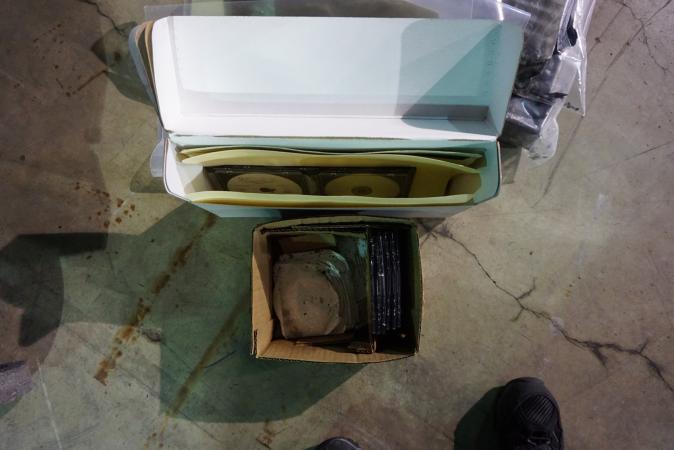The primordial and professional fear of fire flickers forth again in this year’s Halloween post. A few weeks ago, our friends at the Bureau of Alcohol, Tobacco, Firearms, and Explosives’ Fire Research Laboratory permitted us to train another cohort of staff in a model collections storage environment in their medium-sized burn room, nicknamed “The Beast.”
Into the fiery mouth of the beast, we introduced a controlled experiment. Both on the shelf, outside of, and inside a standard archival box in folders, we placed a set of optical disks (CD, CD-R, CD+R, DVD) with variables of condition and exposure (unsleeved, in Tyvek sleeves, and in jewel boxes, with and without labels, and marks). In the opening minute, you can see the gray box marked “SIA Test” installed to the right, on the third shelf, and towards the front of the room. Watch the fire progress toward and spread over the shelf, and then notice the second sprinkler begin to suppress the fire before it immolates our experiment. Note that we intentionally delayed operation of the central automatic sprinkler so that we could see the effects of an expanding fire; also, there is a powerful fan evacuating smoke out the front and up into a capture hood.
What to watch for:
0:25 – ignition
1:00 – fire spreads up a plastic corrugated board, and catches materials stored above the cabinet, beyond the sprinkler’s reach, and along materials on the floor in the rear
3:20 – firefall from plastics above the tall cabinet begins
3:44 – smoke fills the room, travelling at the height of our box to about three-and-a-half feet from the floor, even with the continuous draw toward the fume hood
4:00-08 –the plastic board melts and falls onto our shelf, catching afire from hot gases or transfer
4:27-35 – flames are visible immediately adjacent to our box
4:35 – central sprinkler is released; smoke changes in density
4:48 – water drips appear on our box
5:13 – firefighter enters with additional water suppression; smoke changes again in density
5:47 – second firefighter enters, looking for hot spots
Watching the fire is super scary—especially when you see plastics ignite, melt, spread and feed that great hungry beast. However, seeing the results of fire suppression during immediate salvage offers great relief when you note how the wetted board of the archival box kept the contents visibly cooler than disks that were exposed. When analyzing the data captured on the ATF’s thermocouple on that shelf, we could see that the immediately adjacent temperature rose to 125C / 257F, closer to that of Tyvek (disk sleeves), and below but nearing the melting point of polycarbonate (disks and jewel cases). The other areas were heated up to 906C / 1663F. Our intern Miguel Resendiz is currently working to assess and potentially recover these disks, and will report back whether it is a trick, or treat, on our hands to share with you in future.

Related Resources
- “An Optical Media Preservation Strategy for New York University’s Fales Library & Special Collections,” by Annie Schweikert, 2018
- Error Analysis and File Recovery Software for Digital Storage Media, Vol. 2., by Joe Iraci, 2019
- "Facing Our Fears," by Nora Lockshin, The Bigger Picture, Smithsonian Institution Archives
Produced by the Smithsonian Institution Archives. For copyright questions, please see the Terms of Use.

Leave a Comment